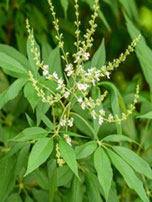SHAHEED KARTAR SINGH SARABHA AYURVEDIC MEDICAL COLLEGE & HOSPITAL
Affiliated to Guru Ravidas Ayurved University, Hoshiarpur Punjab
Affiliated to Guru Ravidas Ayurved University, Hoshiarpur Punjab

Botanical Name: Vitex negundo
Family: Verbenaceae
Introduction :
This leaves of nirgundi used for rubbing diseased part in leprosy. It classified under anusastra
Names in different Indian languages :
Hindi : Samhalu
Telugu : Vavili,tellavalli
Tamil : Nirkundi,nallanocci
English : Five-leaved chaste
Bengali : Nishinda
Kanada : Niragundi,nekka,lakkagida
Malayalam : karunocci
Sanskrit : Nirgundi
Unani : Sambhaalu,Fanjankisht
Synonyms :
Shephaalikaa, Sindhuka, Sindhuvaara, Suvahaa, Sugandhikaa. Nila, Nilanirgundi, Shveta nirgundi , Sinduvaara,
Classification according to Charaka, Susrutha & Vagbhata :
Charaka : Visaghna, Krmighna
Susrutha : Surasadi
Vagbhata : Surasadi
Varieties & adulterants – (CV – controversy, AD – adulterants) :
Morphology :
A shrub or a small tree of about 3m height and underside of leaves pubescent.
Leaves—Tri or penta-foliolate; leaflets lanceolate, middle one will be longer, entire or crenate, glabrate, dark above and pale be- heath.
Flowers— in lateral cymes, small, bluish purple upto 30 cm long.
Fruits— globose and black when ripe.
Seeds— obovate or oblong.
Flowering and fruiting between March-August
Distribution & Habitat :
All over India
Chemical constituents :
casticin , glucosides, luteolin-7-glucoside, vitricine, beta sitosterol, camphene, beta pinenes, angoside, aucubin
Properties :
Rasa : Katu, Tikta
Guna: Laghu, Ruksa
Virya : Usna
Vipaka : Katu
Karma : Vata-Kaphahara, Caksusya, Kesya, Krmi, Vranaropana, vishahara,Digestive, stomachic, anti-inflammatory, diuretic, expectorant, carminative
Toxicity Studies :
oil produces burning sensation and urticaria of used in excessive doses.
Indication :
sula, sotha,vata roga, Amavãta, Krmi, Kustha, Aruci, Vrana, Grdhrasi, Snãyuka, Visarpa, Netra roga, Sãtikã roga, Visa roga, Gandamala,fever, spermatorrhoea, hair loss, cervical spondylosis, .A. , lumbago, cerpain, tuberculosis, leucoderma, cephalgia, memory lose, neural disoeder, skin diseases.
Part used :
Leaves, root, seeds, bark,Tree with serrated leaf type is preferable.
Dosage :
Leaf juice 10-15 ml
Powder 2-4 g
Decoction 50-100 ml
External uses :
Best analgesic. anti-inflammatory, antibacterial, cleaning and healing wounds. hair tonic. Heated nirgundi leaves are tied over the affected part (or poultice) in headache. scrotal swelling. Sinusitis, arthritic pain and rheumatic arthritis. Decoction prepared from leaves is used for tub bath in endometritis, colitis in these conditions it reduces the obstruction of blood and amakapha, increases perspiration. reduces oedema and also relieves pain. Gargles with decoction of leaves is useful in phatyngitis, stomatitis, difficulty in deglutition and inflammation. Smoke of leaves is useful in headache, sinusitis and common cold. Nirgundi oil is best in wounds for cleaning, anti-infective and to remove foul smell. Oil is also useful in baldness. Nirgundi is also called a upanaha vriksha.
Internal uses :
Nervous system It is an analgesic, brain tonic and alleviates vata, therefore useful in headache. sciatica, rheumatic arthritis. synovitis, improves memory
Digestive system : Since it has tikta, katu and ushna properties it improves appetite and digestion. It is useful in loss of appetite, anorexia. amadosha, hepatitis and is anthelmintic.
Circulatory system : White flowered nirgundi is used in oedema induced by kaphavata. As it acts on the raktadhatu and alleviates vata and kapha. it is used in inflammatory conditions of liver and spleen. Mixture of leaf juice and cow’s urine is an effective remedy for ascites, Nirgundi is useful in all inflammatory conditions,
Respiratory system : By removing kapha from respiratory passage, it improves ventilation therefore used in kapha kasa, asthma, pneumonia and pleurisy.
Urinary system : Diuretic, hence useful in dysuria and anuria. In gonorrhoeal infection it helps in passing urine smoothly.
Reproductive system : It improves menstrual flow therefore used in dysmenorrhoea and obstetric conditions.
Skin : Valuable medicine in skin diseases; urticaria and eruptions.
Temperature : It helps in digestion of ama, thus reducing fever. It is used as an anupan or a main drug in typhoid and malaria fever.
Medovahasrotas : Decoction is used as a nasya in cervical lymythadenopathy and topical application at leaves also helps.
Eyes : Leaf juice is installed in conjunctivitis, Surma is prepared from seeds.
Ears : Nirgudi oil is useful (leaves + oil) in reducing pain, oozing, inflammation and fungal infection of ear.
Satmikaran : Every part of the body is stimulated, therefore it acts as a rasayan in body. The combination of sheelajit + nirgudi is best rasayan.
Antidote : Latex of Acacia arabica.
Due to strong (pungent) odour, it is used as a mosquito and bed bug repellent. Also prevents insect growth in stored food grains (insecticidal). A parasitic plant grows on nirgundi in rainy season which is useful in mahakushtha. Also effective in guneaworm infestation.
Important Yogas or Formulations :
Nirgudikalpa, Nirguditail, Nirgudighrit. In large doses it vitiates pitta and therefore causes pitta disorders. Nirgundi taila, Nirgundi Kalpa.
Therapeutic Uses :
1. Vãtavyãdhi— Nirgundi root powder shall be given with oil as Anupãna (R.R.S.).
2. Kãsa,svãsa — Decoction prepared with Nirgundi, Gudüci, Haritaki and Marica (equal parts) is given with salt .
3. Gandamãla— Nirgundi root is pounded with water and given as Nasya (V.M.).
